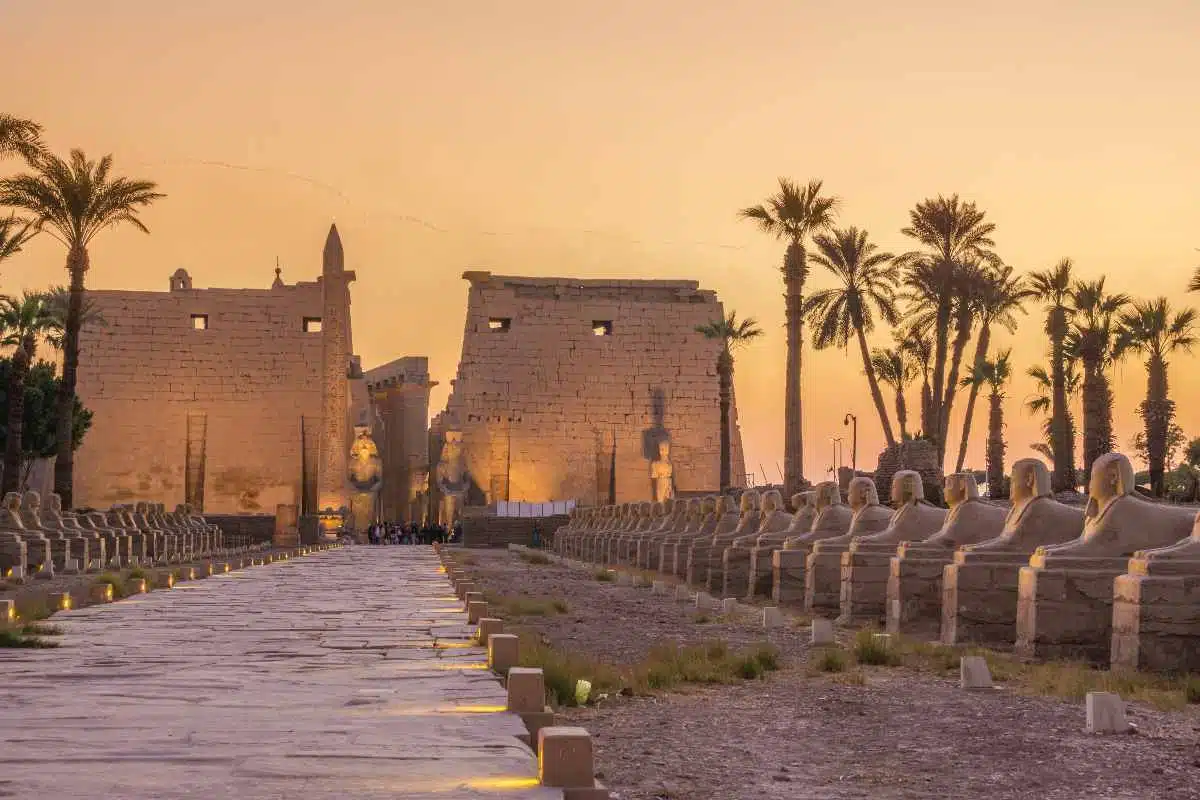Cultural, historical, adventure, and custom customized trips are just a few of the tours that Deluxe trips offer in Egypt and Jordan.

Buried for centuries beneath sand and urban sprawl, the Avenue of Sphinxes, or Way of the Rams, has been unearthed to reveal one of Egypt's most spectacular ceremonial avenues. Approximately 2.7 kilometers (1.7 miles) long, this colossal avenue stretched between the Karnak Temple and Luxor Temple, and its footsteps echoed with priests', pharaohs', and religious processions' feet during Egypt's glorious religious ceremonies. Reopened in 2021 following decades of restoration and excavation work, the Avenue of Sphinxes is a unique open-air archaeological site around the globe.
Avenue of Sphinxes is an ancient ritual avenue lined by over 1,050 sphinx statues, originally built to connect the Karnak and Luxor temples in ancient Thebes (Luxor today). The sphinxes symbolized protection and divine vigilance, guiding religious processions and worshiping gods—most notably Amun-Ra. The avenue was the central point of interest during Opet Festival, an annual large festival, when sacred boats with statues of gods proceeded along the avenue from Karnak to Luxor to rejuvenate the pharaoh's divine power.
What to See Along the Avenue
1. Three Types of Sphinxes
The restored sphinxes exist in different forms depending on where they are located along the avenue: Ram-headed Sphinxes (Criosphinxes) – close to Karnak Temple, representing Amun. Human-headed Sphinxes (Androsphinxes) – most avenue is lined with these, lion bodies and human heads. Hybrid Sphinxes – in addition to Mut Temple, and ram and human head forms.
2. Temples and Chapels Along the Way
In addition to the well-known Karnak and Luxor temples at either end, travelers may see: The Temple of Khonsu The Temple of Mut. Barque shrines where holy boats sought refuge during rituals.
3. Excavated Sections and Restoration
The renovation in the present era uncovered streets, pavements, walls, and sphinxes that dated back to different eras—specifically the 18th Dynasty, 19th Dynasty (Ramses II), and 30th Dynasty (Nectanebo I). Certain statues have inscriptions and detailed paintings.
Where: Luxor, Egypt – East Bank, Length: Approx. 2.7 km from Karnak Temple (north) to Luxor Temple (south), Entry: Part of tours to Karnak or Luxor Temples. Best time to visit: Dawn or evening for cooler temperatures and golden light. Travel Tips for Visiting the Avenue of Sphinxes. Walk in comfortable shoes – It's a long way with limited shade. Start at Karnak Temple – Then head south to Luxor Temple to see the traditional ceremonial direction. Get a guide – To learn about the symbolism and history of the statues and temples. Evening visit – Luxor Temple is breathtakingly gorgeous, and parts of the avenue are illuminated too.
Historical Significance – Walk exactly where pharaohs and priests used to centuries ago. Scale Huge – Over 1,000 sphinxes lined up along a straight axis—unheard of in ancient architecture. Spiritual Energy – The spiritual energy generated by connecting two of Egypt's most powerful temples increases the mystique. New Revival – Reopened following nearly 70 years of restoration and excavation, it's a global cultural icon now. Photo Highlights You Won't Want to Miss Ram-headed sphinxes beside Karnak's first pylon The long shot of the avenue toward Luxor Temple Fine details in restored human-headed sphinxes Golden light casting sunset shots on the statues. Final Thoughts: A Walk Through Time
The Avenue of Sphinxes isn't just a road—it's a sacred pilgrimage along history, linking the grandeur of Karnak and the elegance of Luxor Temple. It's that kind of place that brings ancient Egypt to life beneath your feet and lets you tread the path of gods, kings, and ceremonies once moulding a civilization. Whether you are a history buff, archaeology fanatic, or leisure traveler, the Avenue of Sphinxes is an unforgettable gem of any Luxor travel.
Discover now our answers to the most common questions that may come to your mind about tourism and trips to Egypt
Cultural, historical, adventure, and custom customized trips are just a few of the tours that Deluxe trips offer in Egypt and Jordan.
The Dead Sea, Petra in Jordan, the Pyramids of Giza, Luxor's historic temples, and many other famous sites can be expected to be explored with Deluxe Tours.
offer a hassle-free holiday, Deluxe Tours' packages generally include lodging, transport, meals, guided tours with experienced local experts, and entry fees to attractions.
Spring (March to May) and fall (September to November) offer the finest weather for sightseeing and outdoor activities, making those months the best times to visit Egypt and Jordan.
These two countries are close by, only a 1.5-hour flight apart, and when combined, offer a variety of distinctive experiences. We advise you to spend at least 12 days visiting both countries for a truly unforgettable experience
Combining the eclipse viewing with visits to historic sites like the Pyramids of Giza, the Valley of the Kings, and a Nile River cruise are highly recommended.
